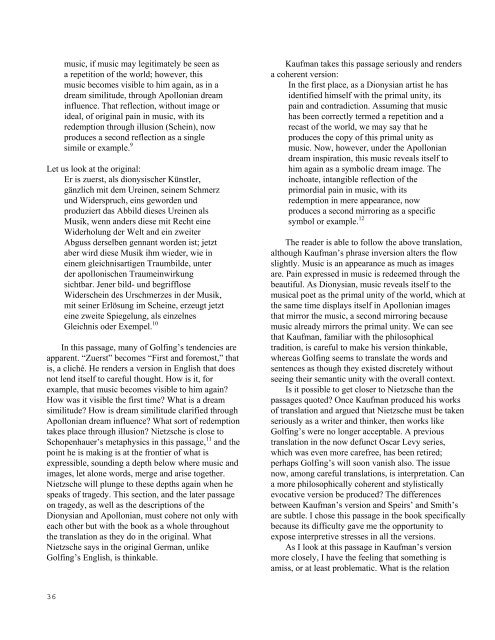their - The University of Texas at Dallas
their - The University of Texas at Dallas
their - The University of Texas at Dallas
You also want an ePaper? Increase the reach of your titles
YUMPU automatically turns print PDFs into web optimized ePapers that Google loves.
music, if music may legitim<strong>at</strong>ely be seen as<br />
a repetition <strong>of</strong> the world; however, this<br />
music becomes visible to him again, as in a<br />
dream similitude, through Apollonian dream<br />
influence. Th<strong>at</strong> reflection, without image or<br />
ideal, <strong>of</strong> original pain in music, with its<br />
redemption through illusion (Schein), now<br />
produces a second reflection as a single<br />
simile or example. 9<br />
Let us look <strong>at</strong> the original:<br />
Er is zuerst, als dionysischer Künstler,<br />
gänzlich mit dem Ureinen, seinem Schmerz<br />
und Widerspruch, eins geworden und<br />
produziert das Abbild dieses Ureinen als<br />
Musik, wenn anders diese mit Recht eine<br />
Widerholung der Welt and ein zweiter<br />
Abguss derselben gennant worden ist; jetzt<br />
aber wird diese Musik ihm wieder, wie in<br />
einem gleichnisartigen Traumbilde, unter<br />
der apollonischen Traumeinwirkung<br />
sichtbar. Jener bild- und begrifflose<br />
Widerschein des Urschmerzes in der Musik,<br />
mit seiner Erlösung im Scheine, erzeugt jetzt<br />
eine zweite Spiegelung, als einzelnes<br />
Gleichnis oder Exempel. 10<br />
In this passage, many <strong>of</strong> Golfing’s tendencies are<br />
apparent. “Zuerst” becomes “First and foremost,” th<strong>at</strong><br />
is, a cliché. He renders a version in English th<strong>at</strong> does<br />
not lend itself to careful thought. How is it, for<br />
example, th<strong>at</strong> music becomes visible to him again<br />
How was it visible the first time Wh<strong>at</strong> is a dream<br />
similitude How is dream similitude clarified through<br />
Apollonian dream influence Wh<strong>at</strong> sort <strong>of</strong> redemption<br />
takes place through illusion Nietzsche is close to<br />
Schopenhauer’s metaphysics in this passage, 11 and the<br />
point he is making is <strong>at</strong> the frontier <strong>of</strong> wh<strong>at</strong> is<br />
expressible, sounding a depth below where music and<br />
images, let alone words, merge and arise together.<br />
Nietzsche will plunge to these depths again when he<br />
speaks <strong>of</strong> tragedy. This section, and the l<strong>at</strong>er passage<br />
on tragedy, as well as the descriptions <strong>of</strong> the<br />
Dionysian and Apollonian, must cohere not only with<br />
each other but with the book as a whole throughout<br />
the transl<strong>at</strong>ion as they do in the original. Wh<strong>at</strong><br />
Nietzsche says in the original German, unlike<br />
Golfing’s English, is thinkable.<br />
Kaufman takes this passage seriously and renders<br />
a coherent version:<br />
In the first place, as a Dionysian artist he has<br />
identified himself with the primal unity, its<br />
pain and contradiction. Assuming th<strong>at</strong> music<br />
has been correctly termed a repetition and a<br />
recast <strong>of</strong> the world, we may say th<strong>at</strong> he<br />
produces the copy <strong>of</strong> this primal unity as<br />
music. Now, however, under the Apollonian<br />
dream inspir<strong>at</strong>ion, this music reveals itself to<br />
him again as a symbolic dream image. <strong>The</strong><br />
incho<strong>at</strong>e, intangible reflection <strong>of</strong> the<br />
primordial pain in music, with its<br />
redemption in mere appearance, now<br />
produces a second mirroring as a specific<br />
symbol or example. 12<br />
<strong>The</strong> reader is able to follow the above transl<strong>at</strong>ion,<br />
although Kaufman’s phrase inversion alters the flow<br />
slightly. Music is an appearance as much as images<br />
are. Pain expressed in music is redeemed through the<br />
beautiful. As Dionysian, music reveals itself to the<br />
musical poet as the primal unity <strong>of</strong> the world, which <strong>at</strong><br />
the same time displays itself in Apollonian images<br />
th<strong>at</strong> mirror the music, a second mirroring because<br />
music already mirrors the primal unity. We can see<br />
th<strong>at</strong> Kaufman, familiar with the philosophical<br />
tradition, is careful to make his version thinkable,<br />
whereas Golfing seems to transl<strong>at</strong>e the words and<br />
sentences as though they existed discretely without<br />
seeing <strong>their</strong> semantic unity with the overall context.<br />
Is it possible to get closer to Nietzsche than the<br />
passages quoted Once Kaufman produced his works<br />
<strong>of</strong> transl<strong>at</strong>ion and argued th<strong>at</strong> Nietzsche must be taken<br />
seriously as a writer and thinker, then works like<br />
Golfing’s were no longer acceptable. A previous<br />
transl<strong>at</strong>ion in the now defunct Oscar Levy series,<br />
which was even more carefree, has been retired;<br />
perhaps Golfing’s will soon vanish also. <strong>The</strong> issue<br />
now, among careful transl<strong>at</strong>ions, is interpret<strong>at</strong>ion. Can<br />
a more philosophically coherent and stylistically<br />
evoc<strong>at</strong>ive version be produced <strong>The</strong> differences<br />
between Kaufman’s version and Speirs’ and Smith’s<br />
are subtle. I chose this passage in the book specifically<br />
because its difficulty gave me the opportunity to<br />
expose interpretive stresses in all the versions.<br />
As I look <strong>at</strong> this passage in Kaufman’s version<br />
more closely, I have the feeling th<strong>at</strong> something is<br />
amiss, or <strong>at</strong> least problem<strong>at</strong>ic. Wh<strong>at</strong> is the rel<strong>at</strong>ion<br />
36

















